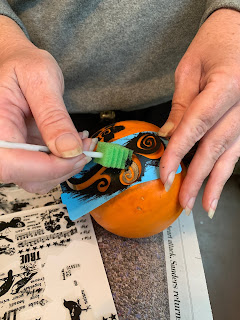Plant Profile: Rosemary
(Rosmarinus
officinalis or Salvia rosmarinus)
Rosemary is a woody perennial or “sub shrub.” Rosemary’s Latin name has been recently
changed to reflect the fact that it is actually part of the sage (or salvia)
family.
It comes in many forms from prostrate to vertical and in
foliage shades that range from blue-green to golden yellow.
Rosemary ‘Arp’ is a reliably hardy variety for the
Mid-Atlantic region. It can withstand our freeze-thaw-freeze winter cycles,
which can often be the demise of other rosemary varieties.
The key is good drainage and full sun. Don’t overwater it
as it is susceptible to root rot. An ideal situation is to plant it overhanging
a rock wall. Be sure to give it room as it can spread to four feet wide and
high.
Rosemary is drought-tolerant and deer-proof. Pollinators
love it. Honeybees are especially attracted to the tiny blue or white flowers.
There is usually no need to fertilize it, though a little
fish fertilizer occasionally will not hurt.
To start new plants, it is best to take cuttings as it is
difficult to grow rosemary from seed.
When using it in cooking, snip off young stems and leaves
for the freshest taste. You can take up to a third of the plant at any one
time, then let it recover before harvesting from it again.
At holiday time, you will see potted-up rosemary plants sold
in grocery stores. These are often quite root-bound and will not live long in
indoor conditions. Take cuttings liberally and use them for cooking and
decoration, then discard the plant when it starts to decline.
Try growing Rosemary in your garden
today – you can grow that!
The video was produced by Washington Gardener Magazine and edited by intern Jessica Kranz.
➤ If you enjoy this video, please give it a thumbs up and subscribe to our Youtube channel (thank you!)
➤Remember to TURN ON notifications to know when our new videos are out
➤ FIND Washington Gardener Magazine ONLINE
~ WashingtonGardener.blogspot.com
~ http://twitter.com/WDCGardener
~ https://www.instagram.com/wdcgardener/
~ facebook.com/WashingtonGardenerMagazine
The video was produced by Washington Gardener Magazine and edited by intern Jessica Kranz.
➤ If you enjoy this video, please give it a thumbs up and subscribe to our Youtube channel (thank you!)
➤Remember to TURN ON notifications to know when our new videos are out
➤ FIND Washington Gardener Magazine ONLINE
~ WashingtonGardener.blogspot.com
~ http://twitter.com/WDCGardener
~ https://www.instagram.com/wdcgardener/
~ facebook.com/WashingtonGardenerMagazine
PIN THIS FOR LATER:















